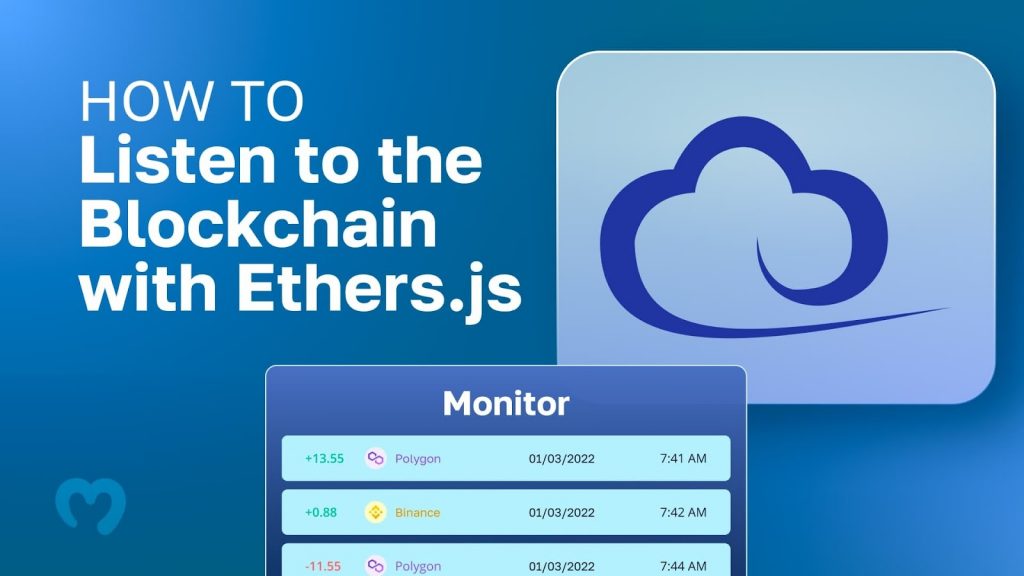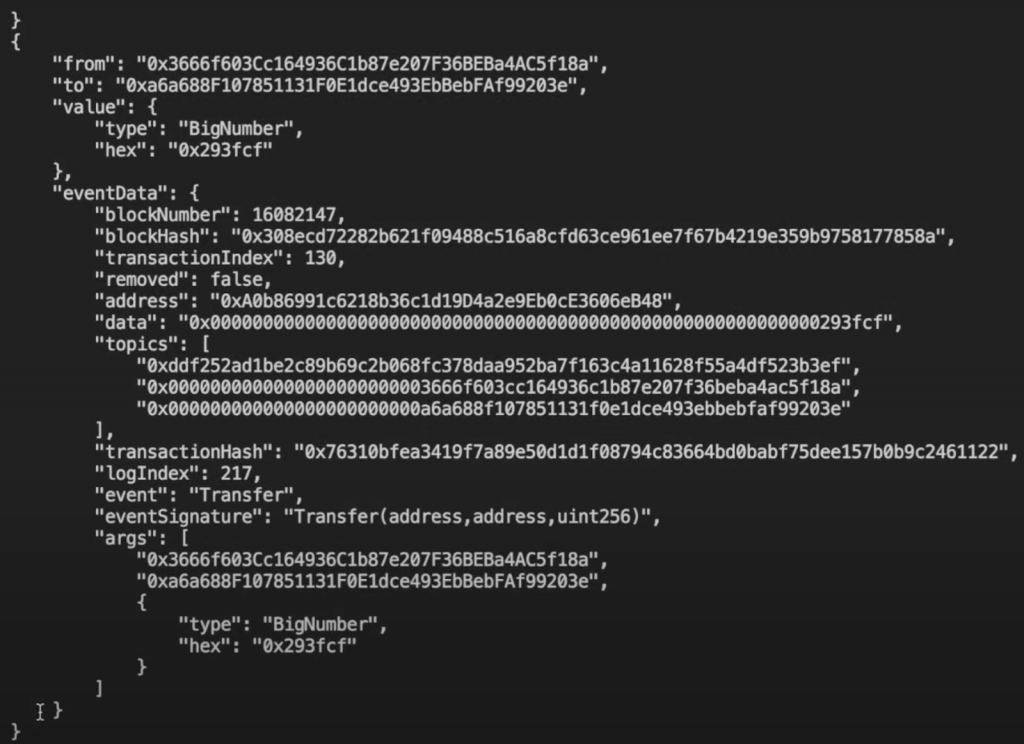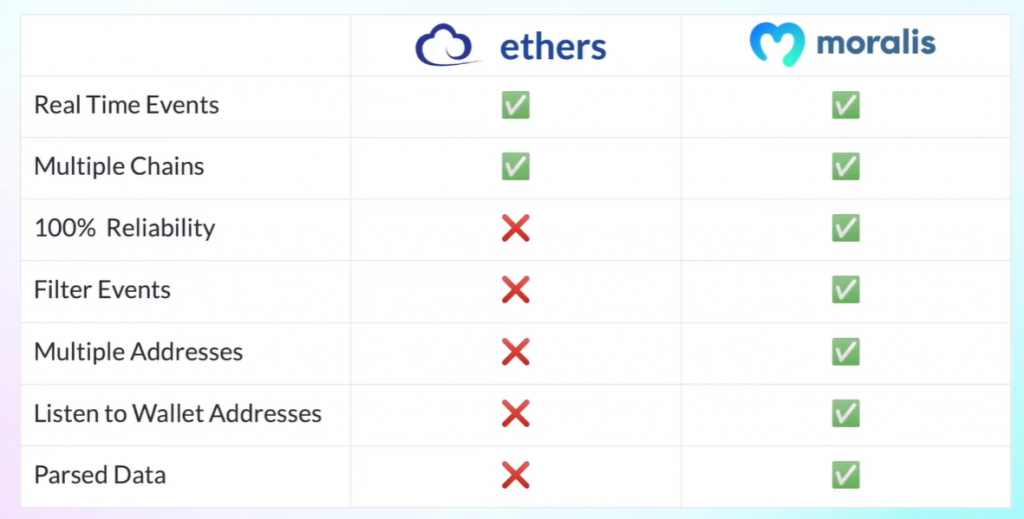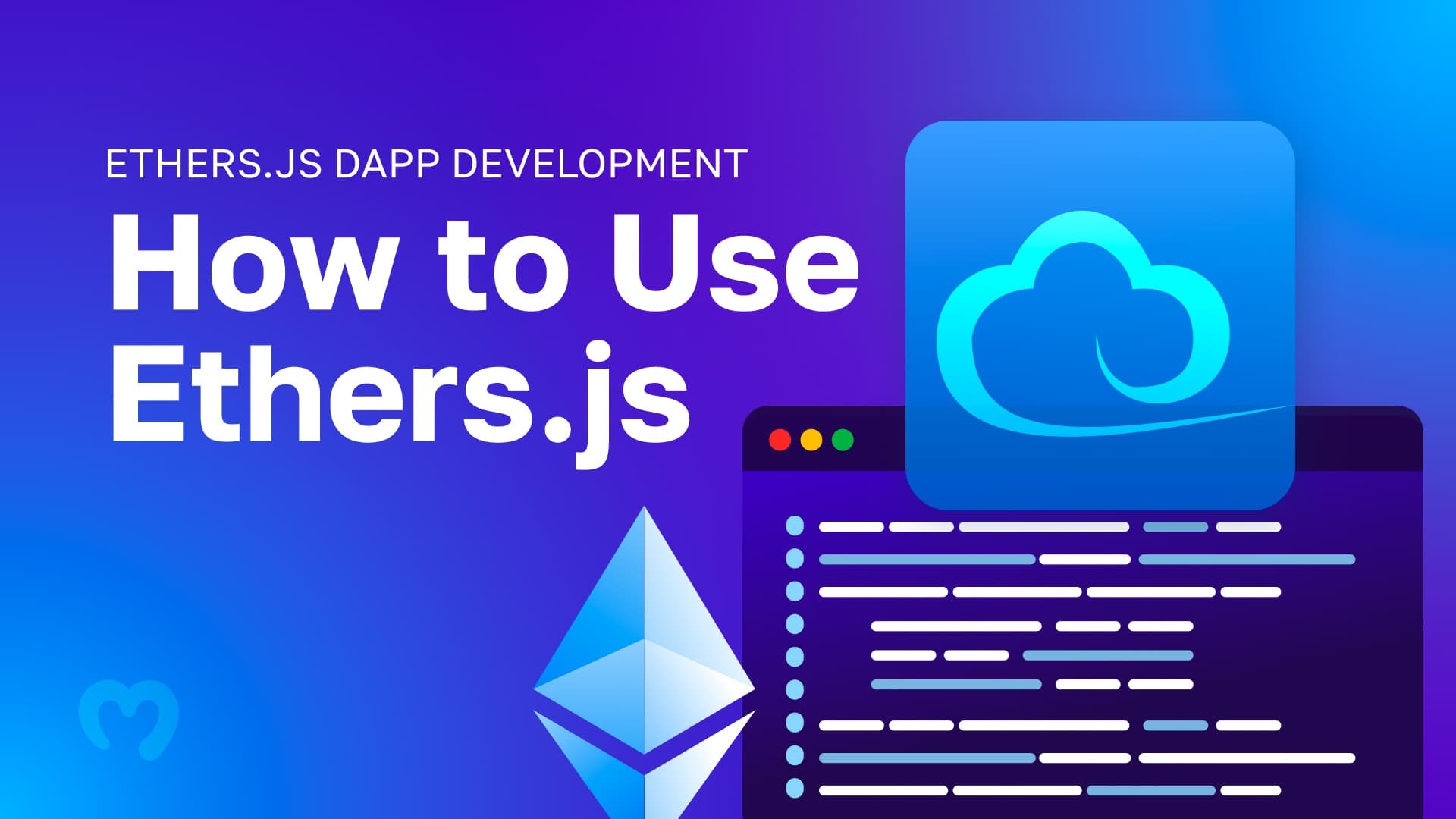Decentralized purposes (dapps) and different Web3 platforms are usually blockchain-based, that means they’re constructed and run on peer-to-peer (P2P) blockchain networks. This means {that a} very important facet of Web3 growth consists of cross-system communications, permitting dapps and numerous blockchain networks to work together with each other. So, as a blockchain developer, how do you allow initiatives to work together seamlessly with the community they’re constructed on? One possibility is to make use of ethers.js, an Ethereum JavaScript library. If this sounds thrilling and also you wish to study extra about ethers.js, be part of us on this tutorial as we discover the intricacies of ethers.js dapp growth!
To reveal how ethers.js dapp growth works, this text walks you thru an instance displaying you how one can use the library to arrange a blockchain listener. Particularly, the article demonstrates how one can monitor switch occasions for the USD Coin (USDC) sensible contract. For those who comply with alongside, it’s also possible to apply the identical rules to hearken to some other sensible contract occasion. Furthermore, together with an ethers.js tutorial, we additionally current one other different for establishing blockchain listeners: the Moralis Web3 Streams API. That is one in all Moralis’ many Web3 APIs enabling a extra seamless programming expertise. What’s extra, that is additionally one in all a number of the reason why Moralis – the perfect Web3 supplier – presents one of many quickest routes to construct a Web3 app!
As such, if you’re critical about moving into Web3 growth, join with Moralis now. Creating an account is free, and it solely takes a few seconds!
What’s Ethers.js?
Ethers.js was launched in 2016 by the developer often called Richard Moore, and it’s an Ethereum JavaScript (JS) library. Ethers.js works equally to standard libraries because it’s a group of prewritten code and features serving to Web3 builders carry out on a regular basis programming duties. Nevertheless, not like conventional libraries, ethers.js is fitted to blockchain growth. As such, builders can use this library to work together extra seamlessly with the Ethereum blockchain community!
Ethers.js was, at first, initially created to work with ”ethers.io”. Nevertheless, since its launch, it has developed to develop into a extra general-purpose library and is one in all at this time’s most distinguished Web3 libraries in the marketplace.
The library consists of 4 principal modules: “ethers.utils“, “ethers.wallets“, “ethers.contract“, and “ethers.supplier“, that are all important for the library’s software programming interface (API). Furthermore, ethers.js’ API construction is user-friendly, and the library is written in TypeScript. As such, it’s intuitive to make use of, making it a best choice amongst blockchain builders.
Nevertheless, what do builders use ethers.js for?
What’s Ethers.js For?
The first goal of ethers.js is to allow seamless interplay with the Ethereum community. As such, builders can use this library to shortly and simply combine Web3 performance into their initiatives. A great instance of what ethers.js can be utilized for is monitoring occasions on a blockchain community.
With ethers.js, you may simply arrange blockchain listeners to watch sensible contract occasions that you’re fascinated about. It’s then potential to combine this info into your Web3 initiatives to create a extra compelling person expertise. That is the place we’ll direct our consideration on this article. If this sounds fascinating, be part of us as we present how one can use ethers.js for dapp growth within the following sections!
In order for you further info on the intricacies of this library, take a look at our article answering the query, ”what’s ethers.js?”.
Use Ethers.js for Dapp Improvement
With a extra profound understanding of ethers.js and what this Web3 library is used for, it’s time for the central a part of this tutorial. Within the following sections, we’ll discover the intricacies of ethers.js dapp growth. In doing so, we’ll present a fast instance of an ethers.js tutorial, displaying you how one can arrange a blockchain listener utilizing this library to watch on-chain switch occasions of the USD Coin (USDC) sensible contract. Nevertheless, by the top of this tutorial, it is possible for you to to use the identical rules to hearken to any sensible contract occasions!

Moreover, we’ll break down the tutorial into the next three steps:
Conditions and Undertaking SetupCreating the Blockchain ListenerRunning the Script
So, if you wish to learn to make the most of ethers.js to hearken to blockchain occasions, be part of us as we kick issues off by overlaying the stipulations and the preliminary mission setup!
Step 1: Conditions and Undertaking Setup
To kickstart this tutorial, we’ll cowl the stipulations and briefly present you how one can arrange the preliminary base mission. To start with, go forward and create a brand new NodeJS mission. From there, add two new information to the basis folder: ”abi.json” and ”.env”. Allow us to shortly break down these information, beginning with the previous.
To the ”abi.json” file, you’ll wish to add the applying binary interface (ABI) of the sensible contract you want to monitor. Consequently, on this occasion, you wish to add the ABI for the USDC sensible contract. To amass the interface, go to “etherscan.io“, seek for and click on on the USDC sensible contract, scroll down, hit the ”Contract” tab, and you can find the ABI underneath the ”Code” part:
From there, copy the ABI and enter the code snippet into your ”abi.json” file.
Subsequent up, when working with the ethers.js library, you want a separate node supplier. For this ethers.js dapp growth tutorial, we’ll use Alchemy, that means that you will need to add your Alchemy key as an surroundings variable to the ”.env” file. To take action, open ”.env”, create a brand new variable known as ”ALCHEMY_KEY”, and enter your key, which you’ll be able to purchase from the Alchemy web site.
That concludes the 2 information; from right here, all that continues to be is putting in the required dependencies. Accordingly, open a brand new terminal and run the next command in your NodeJS mission’s root folder:
npm i ethers dotenv
Step 2: Creating the Blockchain Listener
With the barebones state of the mission all arrange and the required dependencies put in, we’ll now present you how one can create the blockchain listener. So, create a brand new ”index.js” file, open it, and add the next contents on the high:
const ethers = require(“ethers”);
const ABI = require(“./abi.json”);
require(“dotenv”).config();
These preliminary three traces of code make sure that the mission is aware of to make use of ethers.js, together with importing the surroundings variables from the ”.env” file and the USDC sensible contract ABI from ”abi.json”. From there, you’ll wish to create a brand new operate known as ”getTransfers()”. This operate is chargeable for dealing with the logic of the blockchain listener, and it ought to seem like this:
async operate getTransfer(){
const usdcAddress = “0xA0b86991c6218b36c1d19D4a2e9Eb0cE3606eB48”; ///USDC Contract
const supplier = new ethers.suppliers.WebSocketProvider(
`wss://eth-mainnet.g.alchemy.com/v2/${course of.env.ALCHEMY_KEY}`
);
const contract = new ethers.Contract(usdcAddress, ABI, supplier);
contract.on(“Switch”, (from, to, worth, occasion)=>{
let transferEvent ={
from: from,
to: to,
worth: worth,
eventData: occasion,
}
console.log(JSON.stringify(transferEvent, null, 4))
})
}
On the primary two traces throughout the curly brackets of the operate, we create two new variables: ”usdcAddress” and ”supplier”. The ”usdcAddress” variable is ready to the precise deal with of the USDC sensible contract, which we acquired from Etherscan. The ”supplier” variable makes use of the ”ALCHEMY_KEY” surroundings variable from ”.env” to specify the supplier.
Subsequent up, we create a brand new ”contract” object by utilizing the ”usdcAddress”, ”ABI”, and ”supplier” variables, passing them as arguments when calling the ”ethers.Contract()” operate. From there, we use the ”contract” object to specify the subject of curiosity to be ”Transfers”. Consequently, when calling the script, it’ll return info concerning the USDC sensible contract’s switch occasions.
To high issues off, we console-log the outcomes. All in all, your ”index.js” file ought to now look one thing like this:
const ethers = require(“ethers”);
const ABI = require(“./abi.json”);
require(“dotenv”).config();
async operate getTransfer(){
const usdcAddress = “0xA0b86991c6218b36c1d19D4a2e9Eb0cE3606eB48”; ///USDC Contract
const supplier = new ethers.suppliers.WebSocketProvider(
`wss://eth-mainnet.g.alchemy.com/v2/${course of.env.ALCHEMY_KEY}`
);
const contract = new ethers.Contract(usdcAddress, ABI, supplier);
contract.on(“Switch”, (from, to, worth, occasion)=>{
let transferEvent ={
from: from,
to: to,
worth: worth,
eventData: occasion,
}
console.log(JSON.stringify(transferEvent, null, 4))
})
}
getTransfer()
Step 3: Operating the Script
Now that you’ve accomplished the blockchain listener, the ultimate step of this ethers.js dapp growth tutorial revolves round working the script. As such, go forward and open a brand new terminal, ”cd” into the mission’s root folder, enter the command beneath, and hit enter:
node index.js
As quickly as you run the command above, the script will autonomously console-log new switch information related to the USDC sensible contract. To present you an thought of what it would seem like, we’ve included an instance within the picture beneath:

The blockchain listener returns a bunch of USDC switch occasion info. This induces every thing from the “to” and “from” addresses to occasion information, such because the block numbers, block hashes, and so on.
That concludes this ethers.js tutorial. As such, in case you have adopted alongside this far, congratulations! You now know how one can create blockchain listeners utilizing ethers.js!
Nevertheless, despite the fact that utilizing ethers.js for monitoring sensible contract occasions is a good begin, you’ll, sadly, discover that the library has its limitations. As an illustration, the response above doesn’t comprise parsed information. As such, you may, for instance, indirectly decide from the place the switch info originates. Consequently, it’s value trying out some ethers.js dapp growth options!
Ethers.js Dapp Various
The very best ethers.js dapp growth different is Moralis’ Web3 Streams API. With this growth instrument, you may seamlessly arrange Web3 streams, fulfilling the very same operate because the ethers.js-based blockchain listener from the earlier sections and extra. Nevertheless, what precisely is Moralis’ Web3 Streams API, and why is that this a greater different than working with ethers.js?
With the Streams API, you may effortlessly stream on-chain information into the backend of your Web3 initiatives utilizing Moralis webhooks. In consequence, you may monitor sensible contract occasions and obtain webhooks every time a battle begins in your Web3 recreation, an deal with receives, stakes or trades an asset, or different blockchain occasions set off based mostly in your filters! Furthermore, due to the Streams API, you may keep away from redundant duties, corresponding to connecting to buggy RPC nodes, creating pointless abstraction, losing time constructing information pipelines, and rather more!
However, with a considerably higher understanding of Moralis’ Web3 Streams API, allow us to evaluate this different to working with ethers.js. In doing so, we’ll spotlight the similarities between the 2 and persuade you why Moralis is the higher different!
Ethers.js vs Moralis’ Web3 Streams
To start with, allow us to briefly summarize the similarities and variations between ethers.js and Moralis within the desk beneath:

Because the picture above illustrates, Moralis offers every thing that ethers.js has to supply and extra. Nevertheless, learning the desk above might be considerably cryptic. As such, allow us to break down the variations between the 2 choices!
Moralis provides 100% reliability, which ethers.js doesn’t provide, sadly. When utilizing ethers.js, you should provide your personal separate node supplier. That is problematic as you can not, with 100% certainty, make sure that the nodes supplied will stay maintained and operational always. With Moralis, this isn’t the case. The Streams API provides a single tech stack, and also you obtain alerts by way of Web3 webhooks as a substitute.
Furthermore, with ethers.js, you wouldn’t have the power to filter occasions, a function supplied by Moralis. As such, when working with the Streams API, you may simply goal occasions which can be of particulate curiosity to you. As well as, Moralis additionally means that you can pool numerous sensible contracts right into a single stream. This isn’t potential with ethers.js, as you should create new listeners for all separate sensible contracts.
Moreover, with Moralis, you may monitor pockets addresses and obtain webhooks when a pockets partakes in a transaction. Lastly, all the information fed to your webhook URL is parsed. This implies you wouldn’t have to fret about formatting the information and may use it immediately in your initiatives!
For extra details about the similarities and variations, take a look at our information on ethers.js vs Web3 streams. You can even learn to create Web3 streams by watching the video beneath from Moralis’ YouTube channel:
Abstract – Ethers.js Dapp Improvement
In case you have adopted alongside this far, you now know how one can hearken to sensible contract occasions utilizing ethers.js. Moreover, you discovered how to take action in three simple steps:
Conditions and Undertaking SetupCreating the Blockchain ListenerRunning the Script
By finishing these steps, you discovered how one can arrange a blockchain listener for monitoring the USDC contract’s switch occasions. Nevertheless, you may comply with the identical process to watch some other ethers.js occasions that is perhaps of curiosity to you in any future Web3 growth endeavors!
If you’re in search of content material much like what was offered herein, contemplate trying out the Moralis Web3 weblog. The weblog options superb blockchain growth content material the place you, for example, can learn to get all NFT transfers of any pockets. Or, you may delve deeper into different libraries with our article on Web3.js vs ethers.js! Plus, you may discover numerous Web3 networks, such because the Sepolia testnet!
What’s extra, in case you have ambitions to develop into a blockchain developer, join with Moralis now. Creating an account is free, and you’ll instantly leverage the ability of blockchain know-how to its fullest!
































